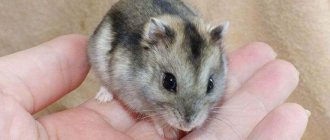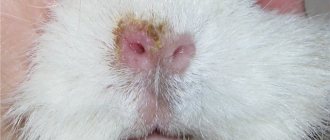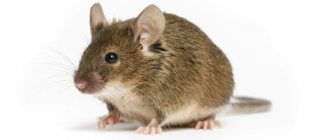- Causes
Older hamsters are more susceptible to serious diseases than young ones. All breeds of rodents, without exception, are susceptible to the occurrence of seals. Cones can have different sizes and densities and be located on different parts of the body. A tumor in a hamster can cause severe pain or be completely painless. In any case, it is necessary to establish the reasons for its appearance and urgently treat the animal.
Causes of seals
It is very sad when a small creature develops tumors. Moreover, they can be of different sizes - from a barely noticeable bump to a huge tumor. Veterinarians say that female Djungarians suffer from this disease much more often than males and representatives of other breeds. This is associated with their reproductive characteristics.
In general, Djungarian hamsters are quite susceptible to diseases; they suffer from viral diseases more often than other breeds. Scientists have long put forward a viral theory of cancer; perhaps it extends to small rodents. The question of what provokes the occurrence of tumors in hamsters has not yet been fully clarified.
However, the reasons for compaction on the body of small animals may be:
- bruises and fractures;
- local reproduction of viruses;
- poor nutrition;
- inflammatory process;
- congenital pathologies.
Since the reasons for the appearance of lumps vary, the types of tumors will also be different.
Diagnosis of the disease
Fats that tend to grow into blood vessels and deep tissues (infiltrative lipomas) are often confused with cancer, so they must be examined carefully.
To determine the nature of the neoplasm, a biopsy (tissue sampling) is performed. In case of infiltrative compaction, computed tomography (CT) is prescribed to determine the extent of tumor damage to blood vessels and muscles.
Histological analysis
Lipoma consists of lobules of adipose tissue separated by connective tissue septa. If there are few blood vessels, then it is dense and damage does not lead to heavy bleeding.
Any neoplasm on the animal’s body must be examined, since there is a risk of degeneration of a benign tumor into a malignant one (liposarcoma).
Types of tumors
Depending on their location, bumps can be external (on the skin and subcutaneous tissue, limbs) and internal (uterine, intestinal tumors).
Based on how neoplasms develop, they are conventionally divided into 3 types:
- Benign. Caused by unlimited cell division, which can be triggered by injury, a virus, or a malfunction of the genetic program. Such neoplasms are usually stable and look like small subcutaneous balls. If you lightly press on the lump, it moves to the side. The density of a benign tumor in hamsters can be anything: hard, soft, or cartilage-like. Such lumps must be removed before they develop into mixed and then malignant neoplasms.
- Malignant. They can develop immediately or gradually change from benign. Malignant cells divide extremely quickly and in all directions; they are not localized, so they metastasize to various organs of the animal. Due to metastases, it is almost impossible to defeat the disease. The occurrence of malignant lumps may be due to viruses, poor nutrition (the carcinogenic effect of fats) or violations of the genetic program.
- Inflamed tissue. The swelling is not caused by cell division and tissue proliferation, but by other factors. This may be an accumulation of pus (abscess) or lymph in certain areas of the body.
In hamsters, inflammatory processes and benign neoplasms are treatable. A malignant tumor manifests itself already in the later stages of the disease, when the “frenzied” cells have already spread throughout the body. Therefore, cancer for a hamster is a death sentence.
This is what a cancerous tumor on a hamster's stomach looks like.
When is surgery needed?
The problem is solved surgically as a last resort when alternative methods are not effective. Surgery is usually needed if a malignant tumor occurs. It is advisable to have time to perform all the manipulations while it is small, so that it is possible to properly close the wound. After the operation, a course of antibiotics, immunomodulators, and vitamins is prescribed. The duration of treatment is at least a week. If the tumor has formed on the internal organs, then there is no point in operating; the animal will not tolerate surgery. The solution is euthanasia.
Localization of neoplasms
Tumors in hamsters can grow anywhere. And the sooner you find it, the higher the chance of saving the fluffy. Therefore, periodically inspect and carefully feel the tiny body. Here are the most common places where a lump can grow:
- head and neck;
- paw;
- tummy.
Internal cancer clusters are almost impossible to detect in the early stages. Therefore, let's pay attention to the external inspection.
Bumps on the head and neck
Viral and bacterial infections provoke inflammation of the cervical lymph nodes in hamsters. This condition is painful, it causes a plaintive squeak in the dwarf. But the pet does not always give a signal to the owner that he is unwell. What symptoms indicate that a tumor in a hamster's neck is causing him discomfort? Firstly, the pet will eat very little, as it hurts to swallow. Secondly, you will notice that he is trying not to turn his head. Having noticed these signs, touch your pet’s neck on both sides under the cheekbones: the inflamed lymph nodes feel like hard balls.
Often, a thickening similar to gumboil appears on the hamster’s face. A tumor on a hamster's cheek indicates inflammation of the oral cavity. This condition can be provoked by too hard food with jagged edges that scratch its cheek pouches (which is why fluffies should not be given fruit tree seeds). Pathogenic bacteria actively multiply in the wounds, causing such severe inflammation that the cheek swells. Sometimes the cheek is so badly damaged that the homa cannot open his eyes.
The photo shows how the hamster's cheek is swollen.
Sometimes animals suffer from eye problems. Conjunctivitis is characterized by suppuration of the eyes and a burning sensation. The hamster keeps trying to scratch his eyes, making the situation worse. If a hamster's eye is swollen, then its owners are to blame. Bedding in a cage that has not been changed for a long time is the surest source of pathogenic bacteria that cause conjunctivitis.
Paw diseases
If your pet is handled carelessly, he may suffer a fracture, bruise or dislocation. True, the owners are not always to blame for the animal’s injuries. He himself is capable of injuring himself by unsuccessfully jumping from the second tier of the cage. Therefore, if your hamster's paw is swollen, a veterinary examination should be performed.
But it’s not only trauma that can cause swelling of a limb. Sometimes furry cats get osteosarcoma, a viral disease that causes bone tissue to grow and surrounding areas to swell. At first, the animal becomes inactive, and the affected limb swells in a matter of days. Inflammation covers the entire limb, then spreads to the torso. Unfortunately, this viral disease has no cure yet.
A slight swelling on the animal's toes may be caused by a splinter. Therefore, veterinarians do not recommend using small sawdust as bedding.
Tumors on the trunk
Sometimes rodents develop tumors on the ventral side of the body. It has been established that tumors in a hamster’s abdomen are more often localized in the mammary glands. The disease is more typical for sexually mature females and can be benign or malignant. Since this is not an intracavitary neoplasm, it can be removed.
Papillomas may appear on the animal’s stomach and armpits. The proliferation of skin tissue is caused by the activity of viruses. The skin disease develops gradually: first, tiny tubercles appear, which over time turn into benign growths similar to warts. If they are not removed, they can grow up to 2 cm, and for the small body of a hamster this is a very noticeable size.
Swelling may also appear under the tail. Many upset owners bring their little one to the veterinarian and complain that the hamster’s butt is swollen and fur has come out in this place. And then they rejoice when the doctor assures them that their pet is a boy, gradually turning into a man. But if Khoma is already old enough, and his butt suddenly starts to swell, it’s still worth going to the doctor. Even hamsters are not immune to testicular cancer.
Habitats and how to arrange a cage. Diseases of Djungarian hamsters
Since some people keep Djungarian hamsters as a pet, their habitat is a cage or a specially equipped terrarium with oxygen supply. Thus, a person can easily track the life cycle of animals. There should be no high structures in cages and terrariums
.
These animals are so agile that they are sometimes clumsy, and this can cause further injury, for example, if they fall from a height. If a hamster falls, it can get bruises or scratches
, which in turn can worsen, leading to more serious consequences. Close observation with due attention to the hamsters will give you the opportunity to promptly notice any deviations from the usual norm.
Let's together highlight some important aspects when arranging the future home of the Djungarian hamster
. The cage should contain a sippy cup, feeders, a house and wheels for games, since these animals, as mentioned earlier, are very mobile. The presence of stairs, tunnels and other household items at your request. Some people arrange the presence of two furious elevations in the cage.
These animals are not very endowed with the instinct of self-preservation by nature; only the close attention of their owners, as well as care for such a cute creature, will help prolong the life of the animal. If you once came up with the idea of getting a Djungarian hamster and you think that you will have no problems coping with such a small creature, then you are mistaken. Before getting an animal, it is worth talking with knowledgeable people who have experience in handling such animals. If you decide to give a gift to a child, then you should give a gentle lecture on handling and care. Any animal in the house is a great responsibility for their owners. The lecture will help you prevent your child from further disappointment.
Treatment
Some bumps are painless for your pet, but that doesn't mean your pet doesn't need to be treated. What to do if you find strange bulges? Of course, consult your doctor.
An ordinary veterinarian can easily recognize eye diseases and prescribe antibiotic treatment. If a hamster has a lump on its neck, it will also not be difficult for him to diagnose inflammation of the lymph nodes. The veterinarian is also able to open the abscess, remove accumulated pus from the wound and treat it.
But with more serious illnesses, you will have to contact a specialist with a narrow profile - a ratologist. This doctor deals exclusively with rodents, examines and makes a diagnosis. One problem: not every city offers appointments with this specialist.
After diagnosis, treatment or surgery is prescribed. If a hamster's cheek is swollen, the doctor will examine the pet's oral cavity, remove foreign objects (possibly embedded in the cheek), and treat the inflamed areas with an antibacterial drug. Usually after the procedure, the swelling subsides within 1-2 days.
If your hamster's butt is swollen but it is not due to puberty, surgery may be necessary. The same situation is with diseases of the mammary glands. Not long ago, operations to remove uterine tumors in rodents became possible. But malignant neoplasms have never been treated. The most humane thing to do is to euthanize an animal with cancer so that it does not suffer.
Skin diseases
Hamsters are susceptible to fungal skin diseases. Then various sores appear on the paws, ears, stomach and other parts of the animal’s body. There is also itching and dandruff.
The following fungal diseases are more often diagnosed in hamsters:
- Dermatophytosis is caused by fungi of the genus Trichophyton and Microsporum. The skin peels off, ulcers appear on the affected area, a grayish coating appears, and hair falls out. Due to itching, the hamster scratches the sore spot, which increases the risk of secondary infection. The disease must be treated with special solutions (Chlorhexidine, Miramistin), ointments, shampoos, which will be prescribed by the doctor.
- Scab is caused by achorions (fungi). You can tell that a hamster is sick by the following symptoms: loose areas of peeling in the eye area, as well as in the hamster’s ear, gray small blisters that turn into crusts and ulcers. Itching and scratching are also present.
- Skin damage by ectoparasites (fleas, lice eaters, ticks). Pet rodents can become ill through contact with infected animals. They can be seen with the naked eye when examining the animal’s body. Most often, parasites live on the skin of the body, but sometimes they infect the ear from the inside. In the latter case, the animal violently shakes its head. This is how a tick infestation manifests itself. Hamsters should be treated with contact insecticides in a safe dosage.
In addition to fungicidal, antibacterial drugs, antiseptic solutions, antiparasitic shampoos, vitamins for hamsters complement the treatment. The latest remedies will help strengthen the animal’s immunity and speed up recovery.
Prevention
Preventive measures cannot fully guarantee protection against cancer and other diseases, but the risk of disease is reduced many times over. To protect your cute animal, follow these rules:
- Clean the cage and wash it often, this will reduce the population of pathogens.
- Do not allow rodents to mate frequently if you have a married couple living with you. Remember that childbirth significantly undermines the body's defenses.
- Do not feed animals fatty foods.
- Take care of your animal's immunity. Fresh herbs and vegetables are great for this purpose.
Following these recommendations will have a good effect on the mood and health of the furry, prevent the occurrence of infectious diseases, and reduce the risk of tumors.
At the first symptoms of the disease, you should not self-medicate, but run to the doctor. Timely diagnosis and therapy will help cope with a number of diseases, but if your furry friend is diagnosed with cancer, you will have to come to terms with it.
Content
- The causative agent of parasitic infection is pinworm
- Causes of pinworm infection
- What complications does the disease cause?
- Symptoms of the disease Acute period
- Chronic stage
Enterobiasis is an infection of the body with helminths - pinworms. Young children are at risk, but children of other ages can also be infected.
Abscess in a hamster
The main symptom of the presence of an abscess formation on the pet’s body is swelling in the neck area, as well as other parts of the body. Other symptomatic manifestations include:
- deterioration of general condition;
- decreased appetite;
- matted wool;
- salivation;
- the presence of purulent discharge from the eyes;
- protrusion of the eyes.
If at least a few accompanying symptoms occur, it is worth showing the baby to a specialist from a veterinary clinic. If diagnosis is not carried out in time, the condition of the baby can be brought to the point where he will require surgical intervention. And given the small size of the animals and their weak heart, it is possible that such an operation will end in death.
Causes
An abscess in a hamster develops for various reasons. The main ones are:
- bites received during fights;
- scratches resulting from collisions with sharp corners of accessories installed in the home;
- wounds from injections on sharp corners.
The skin of the hamsters is damaged, and given the fact that the cage is not frequently cleaned, as a rule, an infection gets into a small wound, which then becomes an abscess formation. Often the fur and skin at the site of its development are damp, since pus may leak from the wound, which a clean animal will definitely lick.
How to treat?
Before starting treatment, you should pay attention to the condition of the place where the abscess has formed. If it is not very red and slightly swollen, surgery will most likely not be required. Timely administration of antibiotics, blockade drugs and the like will prevent the abscess from developing and will lead to its complete resorption.
If the tumor is too large and stands out on the pet’s body, you should immediately contact a veterinary clinic. Such abscesses are opened, cleaned out, and often removed along with the capsule, like malignant tumors. In addition, the baby may need drainage installed, which is not possible to do at home.
When the owner notices that the abscess formation has burst on its own in a short period of time, it is worth treating the wound with furatsilin, hydrogen peroxide and trying to cut off the hair around it. In any case, consultation with a specialist is necessary, if only for the reason that it is necessary to exclude blood contamination by pathogenic microbes, the development of which can lead to death.
Enlarged testicles
Large eggs in mature hamsters are a fairly common occurrence. For example, among Syrians, eggs are visible already at two months of age. When the hair on them thins out, they become even more expressive, and to inexperienced breeders it may seem that they are enlarged.
It's another matter when the testicles are asymmetrical. Most likely it is unilateral cryptorchidism. In this case, one testicle descends into the scrotum, and the second remains outside. This is a pathology that occurs for several reasons:
- During puberty, males accumulate a large amount of sperm. Uneven accumulation in the testes can cause their asymmetrical enlargement.
- Hormonal imbalance due to keeping a female and a male in the same cage.
- Inflammation due to infection. Treatment is carried out with antibiotics, and is not always successful.
- Benign and malignant tumors are removed surgically under general anesthesia.











